
Lizard is the common name used for all squamate reptiles other than snakes, encompassing over 7,000 species, ranging across all continents except Antarctica, as well as most oceanic island chains. The grouping is paraphyletic as some lizards are more closely related to snakes than they are to other lizards. Lizards range in size from chameleons and geckos a few centimeters long to the 3-meter-long Komodo dragon.
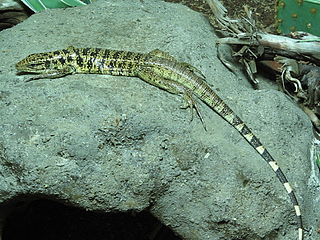
Tupinambis is a lizard genus which belongs to the family Teiidae and contains eight described species. These large lizards are commonly referred to as tegus. T. merianae, T. rufescens, and T. teguixin are popular in the pet trade. They are primarily found in South America, although T. teguixin also occurs in Panama.

Bothrops atrox — also known as the common lancehead, fer-de-lance, barba amarilla and mapepire balsain — is a highly venomous pit viper species found in the tropical lowlands of northern South America east of the Andes, as well as the Caribbean island of Trinidad. No subspecies are currently recognized.

Trinidad and Tobago are continental islands with a geologically very recent history of direct land bridge connection to South America. As a result, unlike most of the Caribbean Islands, Trinidad and Tobago supports a primarily South American flora and fauna and has greater diversity of plant and animal species than the Antilles. However, rates of endemism are lower than in the rest of the Caribbean because there has been less time for genetic isolation from mainland populations because of the history of land bridge connections and hence fewer opportunities for speciation, and so a greater proportion of the species in Trinidad and Tobago are also found on the South American mainland. Trinidad is nearer to mainland South America and has been directly connected to the mainland via land bridges more often and for longer periods than Tobago. This, as well as Trinidad's larger size and more varied topography and hydrology compared to that of Tobago allow greater species and ecosystem diversity on the former compared to that on the later of the islands.

The Nile monitor is a large member of the monitor family (Varanidae) found throughout most of Sub-Saharan Africa, particularly in drier regions, and along the Nile River and its tributaries in East Africa. Additionally, there are modern, invasive populations in North America. The population found in West African forests and savannahs is sometimes recognized as a separate species, the West African Nile monitor. While it is dwarfed by its larger relatives, such as the Komodo dragon, the Asian water monitor or the crocodile monitor, it is still one of the largest lizards in the world, reaching Australia’s perentie in size. Other common names include the African small-grain lizard, as well as iguana and various forms derived from it, such as guana, water leguaan or river leguaan.
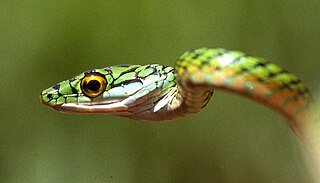
Leptophis ahaetulla, commonly known as the lora or parrot snake, is a species of medium-sized slender snake of the family Colubridae. The species is native to Central America and northern South America.

The Chaco eagle or crowned solitary eagle, is an endangered bird of prey from eastern and central South America. Typically it is known simply as the crowned eagle which leads to potential confusion with the African Stephanoaetus coronatus. Due to its rarity, not much is known about its biology or population.

The Argentine black and white tegu, also known as the Argentine giant tegu, the black and white tegu, or the huge tegu, is a species of lizard in the family Teiidae. The species is the largest of the "tegu lizards". It is an omnivorous species which inhabits the tropical rain forests, savannas and semi-deserts of eastern and central South America.
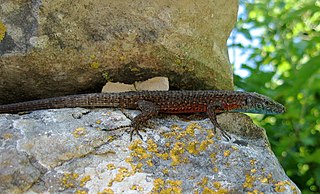
The blue-throated keeled lizard, or Dalmatian algyroides, is a species of lizard in the family Lacertidae.
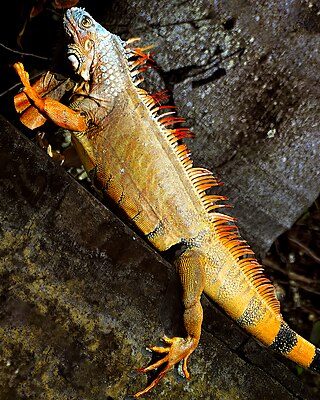
Iguana is a genus of herbivorous lizards that are native to tropical areas of Mexico, Central America, South America, and the Caribbean. The genus was first described in 1768 by Austrian naturalist Josephus Nicolaus Laurenti in his book Specimen Medicum, Exhibens Synopsin Reptilium Emendatam cum Experimentis circa Venena. Three species are placed in the genus: the green iguana, which is widespread throughout its range and a popular pet, the marine iguana and the Lesser Antillean iguana, which is native to the Lesser Antilles. Genetic analysis indicates that the green iguana may comprise a complex of multiple species, some of which have been recently described, but the Reptile Database considers all of these as subspecies of the green iguana.

The red tegu is a lizard native to western Argentina, Bolivia and Paraguay. It is sold in the pet trade around the world due to its ease of care and relatively docile nature.

Tegu is a common name of a number of species of lizards that belong to the families Teiidae and Gymnophthalmidae. Tegus are native to Central and South America. They occupy a variety of habitats and are known for their large size and predatory habits.

The Magdalena–Urabá moist forests (NT0137) is an ecoregion in the north of Colombia. The terrain is largely flat or undulating, but includes mountainous areas in the south. It contains moist forests and large wetlands that are important to resident and migratory birds. The ecoregion forms a bridge between the Pacific coast ecoregions of Colombia and Central America, and the ecoregions of the Andes and Amazon. It is surrounded by the more populated parts of Colombia and is threatened by farming, ranching, logging, oil exploitation and water pollution in the main rivers.

Salvator is a genus of lizards known as tegus which belong to the family Teiidae.
Salvator duseni is a species of lizard in the family Teiidae. The species is sometimes known commonly as the yellow tegu. It is native to South America.
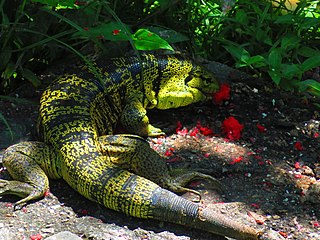
Tupinambis cryptus, the cryptic golden tegu, is a species of lizard in the family Teiidae. It is found in Venezuela, French Guiana, Guyana, Suriname, Brazil, Colombia and Trinidad and Tobago.
Tupinambis palustris, the swamp tegu, is a species of lizard in the family Teiidae. It is endemic to Brazil.
Tupinambis zuliensis, the Maracaibo Basin tegu, is a species of lizard in the family Teiidae. It is endemic to Venezuela.
















